How to Make Blue Stacks Run 60 Fps
Lenovo Yoga 720-15IKB (7700HQ, FHD, GTX 1050) Laptop Review
Convertible Powerhouse. The Lenovo Yoga line has long been the leader in the 2-in-1 notebook market. With the redesigned Yoga 720, the Chinese manufacturer looks to expand that dominance. Can the 15-inch model be flexible enough for consumers, or will it snap under pressure?
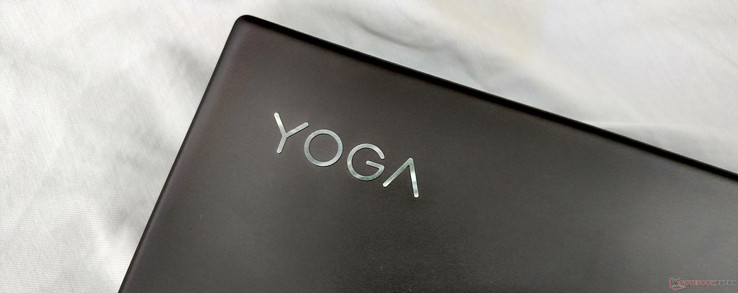
Lenovo has been the dominant force in the convertible notebook market since the introduction of its Yoga notebooks back in 2012. Each year brings new 2-in-1 notebooks with 360-degree hinges, allowing the devices to be used in 4 modes: Laptop, Tent, Stand, and Tablet. Last year's Yoga 710 line was met with critical and commercial success, although there were some quibbles about the keyboard layout, screen flicker, and port selection.
With the Yoga 720 line, Lenovo has made some design tweaks and component upgrades to address these issues. Today we look at the 15-inch model to see what Lenovo has to offer in their largest and most powerful Yoga yet. As with most Lenovo notebooks, the Yoga 720 15 can be configured at the time of purchase, and there is no shortage of choice here. Our model is equipped with the Intel Core i7-7700HQ, the 2 GB variant of NVIDIA's GeForce GTX 1050, and a Full HD (1920x1080) IPS touch screen. Our unit also has 8 GB of RAM and a 256 GB NVMe SSD, both of which come standard on the line but can be upgraded to 16 GB and 1 TB, respectively. Our particular configuration retails from Lenovo for about $1,260, although Lenovo frequently has sales. (At the time of this review, Lenovo was offering this model for $1,049 on their site).
The Yoga 720 under review spans several categories. It obviously fits the bill as a convertible, but the inclusion of the i7-7700HQ and GTX 1050 also make the device suitable as a multimedia notebook. The moderate power of the GTX 1050 also grants the Yoga 720 some gaming chops, albeit at lower settings. As such, we will closely examine all of these factors and see how our unit stacks up against notebooks from each of these categories. For this review, we have chosen the HP Spectre x360 15 and Dell XPS 13 9365 2-in-1, both of which are excellent convertibles. We will also compare the Yoga against some multimedia notebooks, namely the Dell XPS 15 9560 (UHD) and HP Pavilion 15t-bc200. Finally, to get a good sense of its gaming capabilities, we will include the Lenovo Legion Y520 and Samsung Odyssey, both of which are entry-level gaming notebooks. Let's get started.
Memory
8192 MB
, Single-Channel, DDR4-2400
Display
15.60 inch 16:9, 1920 x 1080 pixel 141 PPI, Yes, native pen support, Chi Mei CMN N156HCE-EN1, IPS, glossy: yes
Weight
2 kg ( = 70.55 oz / 4.41 pounds) ( = 0 oz / 0 pounds)
Note: The manufacturer may use components from different suppliers including display panels, drives or memory sticks with similar specifications.
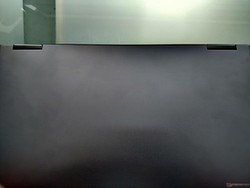
In Lenovo's own words, the Yoga 700 models are their "premium 2-in-1 laptops," and that description is apt here. The 15-inch Yoga 720 has a beautiful all-aluminum chassis that looks and feels great. Our unit is the "Iron Grey" model, which has a dark grey color with a matte finish. The notebook is also available in a brighter "Platinum Silver" option. The case looks subtle and clean, with a nice bright silver trim running around the edge of the chassis. The entire device is well-built with a tight, even gap connecting the keyboard deck to the bottom panel. The finish is highly resistant to fingerprints and able to retain its clean look after handling. The keyboard remains firm when pressed with minimal flex in the center of the deck. The chassis doesn't creak under pressure, and there is no flex during typing. The screen can be twisted only a small bit with direct pressure, although pressing in the center of the lid will noticeably bend the display.
The only complaint we can find is a kink in the left hinge, which could be specific to our particular unit. While it doesn't affect the overall feel of the device, it is noticeable. Speaking of the hinges, the two 360-degree hinges are able to hold the screen in any position with ease. The screen doesn't wobble while typing, although it does rock a bit when touched. It quickly settles back into position, though. Overall, the case looks and feels great.
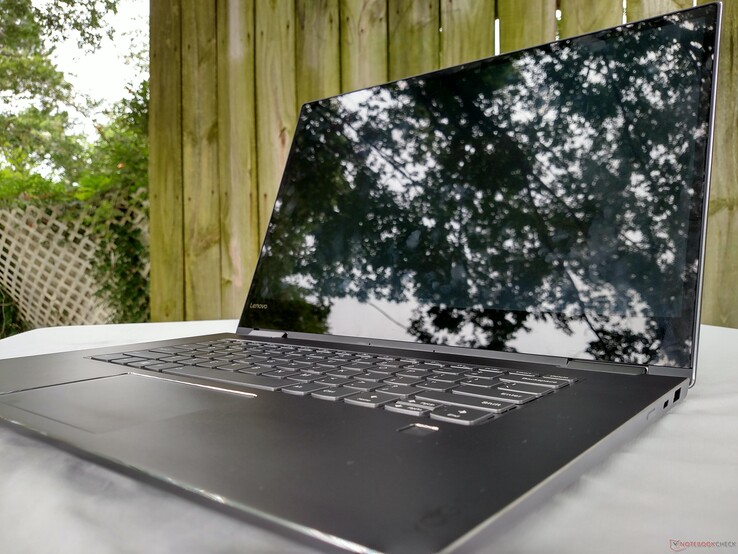
The Yoga 720-15IKB measures in at 364 mm wide by 242 mm deep by 19 mm thick, which is almost the same footprint as the XPS 15 and Spectre x360 15. While it's obviously not as small as the XPS 13, the Yoga feels more akin to a notebook with a 14-inch display thanks to the narrow bezels around the screen. It's quite a bit smaller than the other 15.6-inch notebooks like the Legion Y520 and Pavilion 15t. It's also about half a kilogram lighter than those devices. Lenovo did a good job in making the 15-inch Yoga 720 highly portable without sacrificing screen real estate.
❌
The lack of ports was one of the sticking points with the Yoga 710 line. Sadly, the Yoga 720 took one step forward and two steps back. Connectivity is anemic, and some staple ports are completely absent. Gone is the venerable SD Card reader, and a dedicated display out is sorely missed. Thankfully, users aren't completely out of luck; the presence of a Thunderbolt 3-enabled USB Type-C port brings a lot of versatility. While Thunderbolt 3 can be used for display, high-speed storage, and a myriad of other connections, these all require adapters (there are none included with the device). There are two USB 3.0 Type-A ports, one on either side, for other peripherals. The port layout is great, but the lack of connectivity options may be a difficult pill to swallow for some.
WiFi connectivity is excellent. With transmit and receive speed at 512 and 662 MBit/s, respectively, most users will have no problems transferring files over wireless networks. Web pages load quickly thanks to the tri-band Intel 8265ac WiFi card, and internet connections are rock solid with no drops. The wireless communications speeds sit at the higher end of what modern notebooks offer and handily beat some competing devices while staying in line with the others.
The Lenovo Yoga 720 is equipped with some very nice security features. In addition to software-based TPM in the system BIOS, the notebook comes with a fingerprint scanner on even the base configurations. The scanner is fast and accurate, registering our fingerprint immediately upon touch every single time. This makes for easy and quick logins using Windows Hello and is very nice to have.
The Yoga 720 does not have a Kensington lock or any other means of physically securing the device to a desk. Users should exercise caution to prevent theft and should never leave the device unattended.
Despite the highly restrictive maintenance options of most convertibles, the internals of the Lenovo Yoga 720 are easy to access. The RAM, SSD, and battery can also easily be changed out or upgraded. After removing 10 Torx T4 screws and prying off the bottom panel (which is relatively easy to remove), users will have access to the M.2 SSD and one RAM slot; the other 8 GB of RAM is either located on the other side of the motherboard or (more likely) soldered on. However, the available RAM slot (located underneath a metal shield) can accept another DIMM of DDR4 RAM for a quick upgrade. The fans are also readily accessible for easy cleaning, and the cooling system for both the CPU and GPU can be removed by unscrewing some Phillips Head screws should users want to put on their own thermal compound. Considering the slim profile and convertible form factor, maintenance is surprisingly comprehensive.
Lenovo offers a one year limited warranty. This can extended up to 3 years with either mail-in or on-site service for an additional $149 or $179, respectively. Please see ourGuarantees, Return policies and Warranties FAQ for country-specific information.
Keyboard
The Lenovo name has become synonymous with excellent keyboards, and the Yoga 720 is no exception. While it doesn't have the "wow" factor of ThinkPads, the chiclet keyboard offers firm feedback, ample travel, and is overall great to type on. The pressure point is perfect, and drop is well defined. Keys are well-sized and well-spaced. Our only complaint is the arrow key layout, which feels a bit cramped. However, Lenovo redesigned to arrow keys to allow for a full-sized right Shift key to address complaints concerning the half-sized Shift key of the Yoga 710. This change is very welcome.
The keyboard has a two stage white backlight that is great for dark environments without being so bright that it causes eye-strain. The backlight is fairly even, although keys along the edge of the deck do have some bleed.
Touchpad
The touchpad has a silver trim and a smooth finish that feels great. Tracking is silky and accurate with no hiccups or cursor lag, largely due to the use of Windows Precision drivers. The buttons are integrated into the bottom half of the touchpad. The hinge mechanism used for click input feels great with solid feedback and good travel. Left- and right-clicks register accurately on their respective sides of the pad. Overall, we have no cause for complaint.
Touchscreen
The Yoga 720 has an excellent 10-point touchscreen that registers touch precisely and reliably. The system registered input exactly where we touched, and input lag was minimal. The touchscreen also offers support with Windows Ink, which is a plus for digital artists. Using a compatible pen (like the Lenovo Active Pen), Lenovo advertises that the system can register 4096 levels of pressure. Unfortunately, we did not have an Active Pen on hand to test this claim. The large screen size and weight make the device difficult to hold as a tablet; while touch is responsive, navigating the 15.6-inch display is not an easy task in the hands.
The 15.6-inch glossy IPS display from Chi Mei is colorful and adequate for most use cases. The 1920x1080 resolution is well suited to this screen size; images and text are sharp at 141 pixels per inch, and screen real estate is ample. Lenovo also offers an option with a 4K UHD panel (3840x2160) for an extra $240.
The screen gets reasonably bright at 285 cd/m2, which should be bright enough for most indoor environments. Brightness and colors are even across the panel, making for a uniform display. Response times are also good, hovering between 25 and 30 ms for Black/White and Grey 50%/Grey 80% response. Compared to its rivals, these times are at the front of the pack and good measurements overall. We detect PWM at brightness levels below 70%, but the frequency is incredibly high at over 25 kHz (25,000 Hz) and shouldn't present a problem to most sensitive users.
| 284.8 cd/m² | 288.9 cd/m² | 285.8 cd/m² | ||
| 282.7 cd/m² | 300.9 cd/m² | 279.1 cd/m² | ||
| 277 cd/m² | 285 cd/m² | 283.4 cd/m² | ||
Distribution of brightness
Chi Mei CMN N156HCE-EN1
X-Rite i1Pro 2
Maximum: 300.9 cd/m² (Nits) Average: 285.3 cd/m² Minimum: 0.15 cd/m²
Brightness Distribution: 92 %
Center on Battery: 300.9 cd/m²
Contrast: 1254:1 (Black: 0.24 cd/m²)
ΔE Color 5 | 0.59-29.43 Ø5.3
ΔE Greyscale 7 | 0.64-98 Ø5.6
90% sRGB (Argyll 1.6.3 3D)
59% AdobeRGB 1998 (Argyll 1.6.3 3D)
65.8% AdobeRGB 1998 (Argyll 2.2.0 3D)
90.8% sRGB (Argyll 2.2.0 3D)
65% Display P3 (Argyll 2.2.0 3D)
Gamma: 2.34
| Lenovo Yoga 720-15IKB-80X7 Chi Mei CMN N156HCE-EN1, IPS, 15.60, 1920x1080 | HP Spectre x360 15-bl002xx UHD UWVA eDP BrightView WLED-backlit , IPS, 15.60, 3840x2160 | Dell XPS 13 9365-4537 2-in-1 Sharp LQ133Z1, IPS, 13.30, 3200x1800 | Dell XPS 15 9560 (i7-7700HQ, UHD) IGZO IPS, 15.60, 3840x2160 | HP Pavilion 15t-bc200 X7P44AV LGD04D4, , 15.60, 3840x2160 | Samsung Odyssey NP800G5M-X01US IPS, 15.60, 1920x1080 | Lenovo Legion Y520-15IKBN-80WK001KUS LP156WF6-SPK3, IPS, 15.60, 1920x1080 | |
|---|---|---|---|---|---|---|---|
| Display | -0% | 0% | 33% | -0% | -25% | ||
| Display P3 Coverage | 65 | 67.9 4% | 64.4 -1% | 89.7 38% | 63 -3% | 47.11 -28% | |
| sRGB Coverage | 90.8 | 88.2 -3% | 92.9 2% | 100 10% | 94.4 4% | 70.4 -22% | |
| AdobeRGB 1998 Coverage | 65.8 | 64.4 -2% | 66.1 0% | 100 52% | 64.8 -2% | 48.71 -26% | |
| Response Times | -64% | -34% | -79% | 2% | -28% | -50% | |
| Response Time Grey 50% / Grey 80% * | 29.6 ? | 44 ? -49% | 48 ? -62% | 57.2 ? -93% | 30.4 ? -3% | 38.8 ? -31% | 58.8 ? -99% |
| Response Time Black / White * | 26.4 ? | 38.8 ? -47% | 28 ? -6% | 39.2 ? -48% | 24.8 ? 6% | 33.6 ? -27% | 36 ? -36% |
| PWM Frequency | 25510 ? | 1000 ? -96% | 962 -96% | 19230 ? -25% | 21550 ? -16% | ||
| Screen | 18% | 21% | 6% | -12% | -32% | -37% | |
| Brightness middle | 300.9 | 351.5 17% | 348 16% | 370.1 23% | 259 -14% | 255.9 -15% | 239 -21% |
| Brightness | 285 | 336 18% | 306 7% | 356 25% | 255 -11% | 249 -13% | 244 -14% |
| Brightness Distribution | 92 | 83 -10% | 78 -15% | 87 -5% | 87 -5% | 90 -2% | 88 -4% |
| Black Level * | 0.24 | 0.24 -0% | 0.2 17% | 0.37 -54% | 0.51 -113% | 0.48 -100% | 0.35 -46% |
| Contrast | 1254 | 1465 17% | 1740 39% | 1000 -20% | 508 -59% | 533 -57% | 683 -46% |
| Colorchecker dE 2000 * | 5 | 3.3 34% | 2.79 44% | 5.3 -6% | 3.9 22% | 5.9 -18% | 7.3 -46% |
| Colorchecker dE 2000 max. * | 10.2 | 7.3 28% | 5.53 46% | 9.9 3% | 6.9 32% | 18.9 -85% | 24.7 -142% |
| Greyscale dE 2000 * | 7 | 1.9 73% | 3.47 50% | 4.6 34% | 4.5 36% | 5.6 20% | 4.9 30% |
| Gamma | 2.34 94% | 2.09 105% | 2.54 87% | 2.31 95% | 2.43 91% | 2.21 100% | 2.19 100% |
| CCT | 6578 99% | 6784 96% | 6564 99% | 6284 103% | 7257 90% | 7250 90% | 7332 89% |
| Color Space (Percent of AdobeRGB 1998) | 59 | 64.4 9% | 60 2% | 88.3 50% | 59.5 1% | 44.8 -24% | 35 -41% |
| Color Space (Percent of sRGB) | 90 | 88.2 -2% | 93 3% | 100 11% | 70.1 -22% | 55 -39% | |
| Total Average (Program / Settings) | -15% / -1% | -4% / 9% | -13% / -5% | -3% / -8% | -28% / -30% | -44% / -40% |
* ... smaller is better
Contrast is excellent at about 1250:1. Blacks are deep and uniform; dark scenes look great with no clouding or occlusion. Gamma is also good at 2.34, which outperforms the competition. Colors are reasonably accurate. Our colorimeter pegs the DeltaE for color at 5, while the DeltaE for greyscale averages at 7. The goal for professional color work is a DeltaE of 3 or less; while these DeltaE values miss that mark, they are about average for a consumer-grade notebook. Calibrations is a must for digital artists, though. After calibration, the panel on our unit measure an average color DeltaE of 2.4, and the greyscale DeltaE average fell to 1.8.
Color space is also comparatively good. Covering 90% of the sRGB and 59% of the AdobeRGB color spaces, the panel on our device sits about average for higher-end consumer-grade IPS displays. While professional artists and color workers should look at other notebooks (like the Dell XPS 15), the color gamut of the Lenovo Yoga 720 should be more than adequate for the average user. Colors are crisp, vibrant, and uniform across the display.
Viewing angles are great, as is expected of an IPS display. Images and text remain vibrant and legible from extreme angles (over 45º), although there is a slight blue cast when viewing the screen from the side at angles of about 60° or more. This color shift is noticeable on white backgrounds, but is very subtle and doesn't detract from the most images.
Display Response Times
ℹ
Display response times show how fast the screen is able to change from one color to the next. Slow response times can lead to afterimages and can cause moving objects to appear blurry (ghosting). Gamers of fast-paced 3D titles should pay special attention to fast response times.
| ↔ Response Time Black to White | ||
|---|---|---|
| 26.4 ms ... rise ↗ and fall ↘ combined | ↗ 15.6 ms rise | 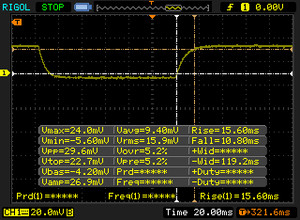 |
| ↘ 10.8 ms fall | ||
| The screen shows relatively slow response rates in our tests and may be too slow for gamers. In comparison, all tested devices range from 0.8 (minimum) to 240 (maximum) ms. » 55 % of all devices are better. This means that the measured response time is worse than the average of all tested devices (23.3 ms). | ||
| ↔ Response Time 50% Grey to 80% Grey | ||
| 29.6 ms ... rise ↗ and fall ↘ combined | ↗ 15.6 ms rise | 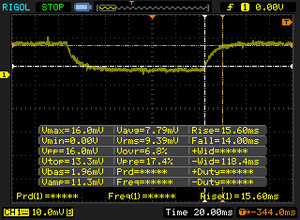 |
| ↘ 14 ms fall | ||
| The screen shows relatively slow response rates in our tests and may be too slow for gamers. In comparison, all tested devices range from 0.692 (minimum) to 636 (maximum) ms. » 26 % of all devices are better. This means that the measured response time is better than the average of all tested devices (36.7 ms). | ||
Screen Flickering / PWM (Pulse-Width Modulation)
ℹ
To dim the screen, some notebooks will simply cycle the backlight on and off in rapid succession - a method called Pulse Width Modulation (PWM) . This cycling frequency should ideally be undetectable to the human eye. If said frequency is too low, users with sensitive eyes may experience strain or headaches or even notice the flickering altogether.
| Screen flickering / PWM detected | 25510 Hz | ≤ 69 % brightness setting | 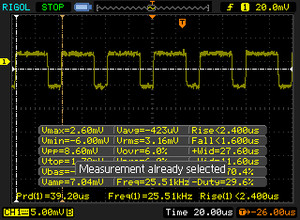 |
| The display backlight flickers at 25510 Hz (Likely utilizing PWM) Flickering detected at a brightness setting of 69 % and below. There should be no flickering or PWM above this brightness setting. The frequency of 25510 Hz is quite high, so most users sensitive to PWM should not notice any flickering. In comparison: 52 % of all tested devices do not use PWM to dim the display. If PWM was detected, an average of 21751 (minimum: 5 - maximum: 3846000) Hz was measured. | |||
Due to the glossy finish and average brightness of the display, the Yoga 720 is not usable in daylight. Reflections obscure anything displayed on the screen, rendering it useless in bright light. While under shade or in brightly lit rooms, reflections still present a problem, but the screen is legible at high brightness settings.
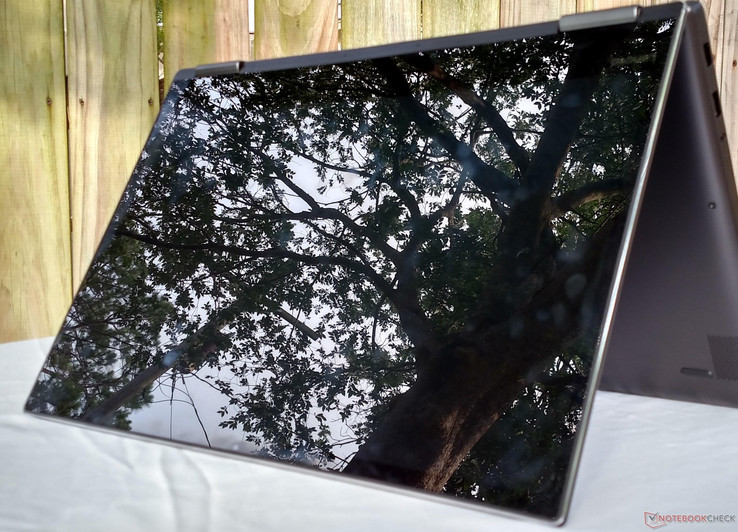
The 15-inch Yoga 720 stands out among other convertibles due to its internal components. While most 2-in-1 devices opt for lower-powered dual core CPUs from Intel's U or Y lineups, the 720 is equipped with Intel's i7-7700HQ, a true quad-core processor. The inclusion of a dedicated GPU also places the Yoga 720 leaps and bounds ahead of most other convertibles. Let's take a look at what these upgrades mean for overall performance.
The Lenovo is powered by the Intel Core i7-7700HQ, a quad-core CPU with a base clock of 2.8 GHz and a boost clock of up to 3.8 GHz. This CPU is commonly found in much more powerful notebooks, particularly ones aimed at the gaming market. Our review unit puts up a good show, coming in at 603 in Cinebench R15's multi-threaded test. This is in line with other multimedia notebooks like the HP Pavilion 15t, but falls behind gaming-oriented notebooks like the Lenovo Legion Y520 and Samsung Odyssey.
Compared to other convertible notebooks, however, the Yoga 720 is in a league of its own. Both the HP Spectre x360 15 and Dell XPS 13 2-in-1 can only muster multi-threaded performance about half that of the Yoga. This is unsurprising, as the other convertibles are equipped with low-powered dual-core chips that cap out at 4 threads. The 7700HQ is a true quad-core with Hyperthreading, meaning that it can run 8 threads simultaneously. Quad-core CPUs aren't typically found in convertibles; as such, the Yoga 720 is a true powerhouse in its class.
The 7700HQ performs much the same on battery with no significant drop in performance. Running Cinebench R15 multiple times in a row produces some unusual results, however. Oddly, performance irregularly ramps up until it peaks at 690 points for multiple runs. After a while, there is a sudden drop back down to around 600 points. This behavior suggests something odd may be happening either with Cinebench or with drivers for the CPU. While these exact results are not repeatable, running the same test results in more odd behavior with the machine erratically posting scores between 600 and 700 points. As such, we cannot deem the processor as stable at this time. Future updates may correct this problem.
For more information on the Intel Core i7-7700HQ, visit our dedicated CPU page here.
Cinebench R15 CPU Multi 64 Bit
Cinebench R10 Shading 32Bit
8755
Cinebench R10 Rendering Multiple CPUs 32Bit
23239
Cinebench R10 Rendering Single 32Bit
5942
Cinebench R11.5 OpenGL 64Bit
58 fps
Cinebench R11.5 CPU Multi 64Bit
6.67 Points
Cinebench R11.5 CPU Single 64Bit
1.36 Points
Cinebench R15 Ref. Match 64Bit
99.6 %
Cinebench R15 OpenGL 64Bit
90 fps
Cinebench R15 CPU Multi 64Bit
603 Points
Cinebench R15 CPU Single 64Bit
120 Points
Help
Overall system performance is quick and responsive. Scores from the various PCMark 8 tests are expected considering the components and are in line with competitors. System navigation is smooth with no hiccups or stutters. The combination of a powerful quad-core processor, efficient GPU, speedy NVMe SSD, and an adequate amount of RAM sum to a smooth user experience.
| PCMark 8 | |
| Home Score Accelerated v2 | |
| Samsung Odyssey NP800G5M-X01US | |
| Lenovo Yoga 720-15IKB-80X7 | |
| Dell XPS 15 9560 (i7-7700HQ, UHD) | |
| HP Pavilion 15t-bc200 X7P44AV | |
| HP Spectre x360 15-bl002xx | |
| Dell XPS 13 9365-4537 2-in-1 | |
| Work Score Accelerated v2 | |
| Samsung Odyssey NP800G5M-X01US | |
| Lenovo Yoga 720-15IKB-80X7 | |
| Dell XPS 15 9560 (i7-7700HQ, UHD) | |
| HP Spectre x360 15-bl002xx | |
| HP Pavilion 15t-bc200 X7P44AV | |
| Creative Score Accelerated v2 | |
| Samsung Odyssey NP800G5M-X01US | |
| Dell XPS 15 9560 (i7-7700HQ, UHD) | |
| HP Pavilion 15t-bc200 X7P44AV | |
| Lenovo Yoga 720-15IKB-80X7 | |
| HP Spectre x360 15-bl002xx | |
| PCMark 8 Home Score Accelerated v2 | 3670 points | |
| PCMark 8 Creative Score Accelerated v2 | 4698 points | |
| PCMark 8 Work Score Accelerated v2 | 4771 points | |
| Help | ||
The Samsung PCIe NVMe SSD in our test unit is blazing fast. Access speeds are mind-blowing at about 2 GB/s and handily beat other rivals, save for Samsung's own Odyssey. Write speeds are also very fast at about 1200 MB/s, making for very quick save times and file transfers. Again, the competition cannot keep up. Lower-tiered NVMe drives, like the Toshiba SSD found in the Dell XPS 13 2-in-1, offer only about half the drive performance. Standard SATA SSDs should fall even further behind.
Sequential Read: 2046 MB/s
Sequential Write: 1213 MB/s
4K QD32 Write: 369.2 MB/s
Sequential Read: 2277MB/s
Sequential Write: 311.7MB/s
Access Time Write: 4.15ms
Whereas most 2-in-1's rely on integrated graphics baked into the CPU die, the Lenovo Yoga 720 is instead outfitted with a dedicated GPU. The NVIDIA GeForce GTX 1050 is an entry-level graphics card but offers a substantial improvement over the Intel HD Graphics found in other convertibles like the XPS 13 2-in-1. It should be noted that Lenovo has opted to use a GTX 1050 with only 2 GB of GDDR5 VRAM as opposed to the more common (and powerful) 4 GB variant. However, as shown by the 3DMark Fire Strike test, this difference shouldn't result in any noticeable detriment. Larger amounts of VRAM become especially important at higher resolutions (1440p and higher, in particular); as long as settings are set reasonably and resolutions are kept to 1920x1080, the GPU performance of the Yoga 720 should be comparable to that of other notebooks.
Compared to the Spectre x360 15, which uses NVIDIA's GeForce 940MX, the Yoga 720 performs 2-3 times better, depending on the application or game. As such, our review unit may prove a good choice to those in search of a convertible notebook with much more power than other 2-in-1's. Users in need of better graphical performance should look at notebooks with the GeForce GTX 1050 Ti. The Lenovo Legion Y520, which sports the GTX 1050 Ti, comes in about 30% higher in Fire Strike.
For more information about the NVIDIA GeForce GTX 1050, visit our dedicated GPU page here.
| 3DMark | |
| 1280x720 Cloud Gate Standard Graphics | |
| Lenovo Legion Y520-15IKBN-80WK001KUS | |
| Samsung Odyssey NP800G5M-X01US | |
| Lenovo Yoga 720-15IKB-80X7 | |
| HP Pavilion 15t-bc200 X7P44AV | |
| Dell XPS 15 9560 (i7-7700HQ, UHD) | |
| HP Spectre x360 15-bl002xx | |
| 1920x1080 Fire Strike Graphics | |
| Lenovo Legion Y520-15IKBN-80WK001KUS | |
| Dell XPS 15 9560 (i7-7700HQ, UHD) | |
| Samsung Odyssey NP800G5M-X01US | |
| HP Pavilion 15t-bc200 X7P44AV | |
| Lenovo Yoga 720-15IKB-80X7 | |
| HP Spectre x360 15-bl002xx | |
| 1920x1080 Ice Storm Extreme Graphics | |
| Samsung Odyssey NP800G5M-X01US | |
| Lenovo Legion Y520-15IKBN-80WK001KUS | |
| Dell XPS 15 9560 (i7-7700HQ, UHD) | |
| Lenovo Yoga 720-15IKB-80X7 | |
| HP Spectre x360 15-bl002xx | |
| 3DMark Ice Storm Standard Score | 54150 points | |
| 3DMark Cloud Gate Standard Score | 17421 points | |
| 3DMark Fire Strike Score | 5278 points | |
| 3DMark Fire Strike Extreme Score | 2595 points | |
| Help | ||
The GeForce GTX 1050 is currently the lowest tier of NVIDIA's mobile GPUs based on the Pascal architecture. While it isn't a gaming powerhouse by any means, the GTX 1050 is well-suited for moderately demanding titles at Full HD. Heavier games, like The Witcher 3 orRise of the Tomb Raider, will require settings to be turned down or resolutions to be reduced for smooth gameplay. Older titles also run well and shouldn't present much of a problem.
Resolutions higher than Full HD (1920x1080) are out of the question here. Aside from the fact that the GTX 1050 is not designed for 2K or 4K gameplay, the limiting 2 GB of VRAM will fast become a problem.
That said, the 15-inch Yoga 720 is the notebook to get for gamers looking for a 2-in-1. While other convertibles can barely break 30 frames per second at minimum settings and low resolutions, the Yoga 720 can comfortably handle the latest titles (albeit not at max settings).
Gameplay over long periods is solid. RunningThe Witcher 3 for an hour yields framerates between 22 and 24 fps with no discernible dips or spikes. Stutter during long gameplay sessions shouldn't be a problem.
The Witcher 3 ultra
| BioShock Infinite - 1920x1080 Ultra Preset, DX11 (DDOF) (sort by value) | |
| Lenovo Yoga 720-15IKB-80X7 | |
| HP Spectre x360 15-bl002xx | |
| Dell XPS 13 9365-4537 2-in-1 | |
| Dell XPS 15 9560 (i7-7700HQ, UHD) | |
| Samsung Odyssey NP800G5M-X01US | |
| Lenovo Legion Y520-15IKBN-80WK001KUS | |
| Rise of the Tomb Raider - 1920x1080 Very High Preset AA:FX AF:16x (sort by value) | |
| Lenovo Yoga 720-15IKB-80X7 | |
| HP Spectre x360 15-bl002xx | |
| Dell XPS 15 9560 (i7-7700HQ, UHD) | |
| Samsung Odyssey NP800G5M-X01US | |
| Lenovo Legion Y520-15IKBN-80WK001KUS | |
| Lenovo Yoga 720-15IKB-80X7 NVIDIA GeForce GTX 1050 Mobile, Intel Core i7-7700HQ | MSI WS63 7RF-290US NVIDIA Quadro P3000, Intel Core i7-7700HQ | Dell Precision 3520 NVIDIA Quadro M620, Intel Core i7-7820HQ | Asus VivoBook Pro 17 N705UD-EH76 NVIDIA GeForce GTX 1050 Mobile, Intel Core i7-8550U | |
|---|---|---|---|---|
| SPECviewperf 12 | 450% | 72% | 35% | |
| 1900x1060 Solidworks (sw-03) | 25.9 | 102.9 297% | 55.3 114% | 32.6 26% |
| 1900x1060 Siemens NX (snx-02) | 4.3 | 71.8 1570% | 27.54 540% | 4.53 5% |
| 1900x1060 Showcase (showcase-01) | 28.5 | 54.8 92% | 20.17 -29% | 27.04 -5% |
| 1900x1060 Medical (medical-01) | 19 | 29.82 57% | 10.34 -46% | 16.23 -15% |
| 1900x1060 Maya (maya-04) | 42 | 67.7 61% | 25.21 -40% | 45.74 9% |
| 1900x1060 Energy (energy-01) | 0.87 | 7.7 785% | 0.62 -29% | 3 245% |
| 1900x1060 Creo (creo-01) | 15.7 | 87 454% | 35.26 125% | 17.43 11% |
| 1900x1060 Catia (catia-04) | 25.3 | 96.5 281% | 33.32 32% | 25.43 1% |
| 1900x1060 3ds Max (3dsmax-05) | 38.9 | 32.47 -17% |
Stressing the notebook using synthetic tests can give us an idea of how the device will operate under absolute worst case scenarios. Using Prime95 to tax the CPU, we see that the 7700HQ is fairly conservative in its clock speeds. After an hour of stress, the processor settles in at its base clock of 2.8 GHz with intermittent bursts up to its max turbo of 3.8 GHz. Temperatures remain very well managed at about 79º C. Maximum temperatures never exceed 84º C; considering the stress that Prime95 puts on a CPU, this is a great result.
Using FurMark to measure the limits of the GPU give the GTX 1050 a chance to shine. After an hour of extreme stress, we see the GPU average at about 1480 MHz, which is just shy of its rated boost clock of 1493 MHz. The GTX 1050 was even able to exceed this boost at times, reaching a maximum core clock of 1518 MHz. Temperatures are still well managed, averaging at 82º C. The CPU, however, averaged 89º C during the test; we suspect some residual heat from the GPU may be running over the CPU die, which would raise temperatures. Both components are close to each other on the motherboard and share the same heat pipes for dissipation, so this may be the case.
The system does not fare as well when both FurMark and Prime95 are running. While the GPU continues to exceed expectations, averaging a core clock of an impressive 1506 MHz and temperatures of 79º C, the CPU is hit hard and aggressively throttles. Average clock speeds are a measly 800 MHz. This result is very surprising, as temperatures remain relatively cool at about 75º C. However, looking at the measurements over time, we see that the CPU isn't able to hold even its base clock without temperatures quickly approaching 100º C, which is the rated thermal limit for the i7-7700HQ. Lenovo seems to have tuned the system this way to control heat. This is sensible, as the device may be put under stress when in tablet mode. This aggressive underclocking may be an attempt to keep temperatures and noise down while the device is in users' hands.
Running The Witcher 3 gives us a more realistic picture of what to expect while running real-world applications for extended periods of time. Here, the system performs well. The CPU sits at its base clock for the majority of the gameplay session, while the GPU again does very well, averaging about 1580 MHz on its core. Temperatures for both hover around 80º C, which are good given the form factor and level of performance. All said, the notebook keeps its cool under realistic stress and still performs well.
| CPU Clock (GHz) | GPU Clock (MHz) | Average CPU Temperature (°C) | Average GPU Temperature (°C) | |
| Prime95 Stress | 2.8 | - | 79 | - |
| FurMark Stress | 2.8 | 1481 | 89 | 82 |
| Prime95 + FurMark Stress | 0.8 | 1506 | 75 | 79 |
| Witcher 3 Stress | 2.8 | 1580 | 80 | 79 |
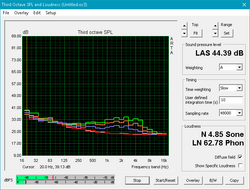
System noise is very good. At idle, the fans are completely silent, ramping up only once heavier programs are loaded. Under maximum load, sound averages at 39 dB(A), which is barely audible above normal environmental noise There are occasional bursts up to 46.3 dB(A), but we only measure these under intense load (such as during stress testing). Even while playing intense titles like Rise of the Tomb Raider, system noise stays manageable and hovers around 40 dB(A). While other convertibles are much quieter or even silent (like the XPS 13 2-in-1), keep in mind that the Yoga is able to keep noise low with much more powerful components.
Coil whine is not present in our review unit.
Noise Level
| Idle | 28.2 / 28.2 / 28.2 dB(A) | |
| Load | 39 / 46.3 dB(A) | |
 | ||
| 30 dB 40 dB(A) 50 dB(A) | ||
| min: | ||
| Lenovo Yoga 720-15IKB-80X7 GeForce GTX 1050 Mobile, i7-7700HQ, Samsung PM961 MZVLW256HEHP | Dell XPS 13 9365-4537 2-in-1 HD Graphics 615, i5-7Y54, Toshiba NVMe THNSN5256GPUK | Dell XPS 15 9560 (i7-7700HQ, UHD) GeForce GTX 1050 Mobile, i7-7700HQ, Lite-On CX2-8B512-Q11 | HP Pavilion 15t-bc200 X7P44AV GeForce GTX 1050 Mobile, i7-7700HQ, Intel SSD 600p SSDPEKKW256G7 | Samsung Odyssey NP800G5M-X01US GeForce GTX 1050 Mobile, i7-7700HQ, Samsung PM961 NVMe MZVLW128HEGR | Lenovo Legion Y520-15IKBN-80WK001KUS GeForce GTX 1050 Ti Mobile, i7-7700HQ, Samsung PM961 MZVLW256HEHP | HP Spectre x360 15-bl002xx GeForce 940MX, i7-7500U, Toshiba XG4 NVMe (THNSN5512GPUK) | |
|---|---|---|---|---|---|---|---|
| Noise | -7% | -9% | -6% | -3% | -6% | ||
| off / environment * | 28.2 | 28.4 -1% | 28.9 -2% | 28.1 -0% | 27.7 2% | 28.5 -1% | |
| Idle Minimum * | 28.2 | 29 -3% | 32.3 -15% | 28.1 -0% | 30.5 -8% | 28.5 -1% | |
| Idle Average * | 28.2 | 29 -3% | 32.3 -15% | 29.1 -3% | 30.5 -8% | 28.5 -1% | |
| Idle Maximum * | 28.2 | 32.2 -14% | 32.3 -15% | 29.1 -3% | 30.6 -9% | 36.3 -29% | |
| Load Average * | 39 | 47.1 -21% | 43.2 -11% | 49.2 -26% | 40 -3% | 42.7 -9% | |
| Load Maximum * | 46.3 | 47.1 -2% | 45.2 2% | 49.2 -6% | 42.6 8% | 42.7 8% | |
| Witcher 3 ultra * | 52 | 40 |
* ... smaller is better
Temperatures remain fairly cool, save for one key spot: the top center of both the keyboard deck and underside get uncomfortably hot to the touch. This is the spot where most heat is exhausted and should not be touched when the device is under load. The palm rest and keyboard get warm but are not uncomfortable. Hands will get sweaty, though.
The temperatures suggest that the device should only be held in tablet mode under light load (e.g., watching videos, drawing, light gaming). Running heavy applications while holding the device will result in a hot (and possibly painful) experience if the notebook is held in the wrong spot.
| |||||||||||||||||||||||||
| Maximum: 42.8 °C = 109 F Average: 35.7 °C = 96 F | |||||||||||||||||||||||||
| |||||||||||||||||||||||||
| Maximum: 49.6 °C = 121 F Average: 38.2 °C = 101 F | |||||||||||||||||||||||||
Power Supply (max.) 40.8 °C = 105 F | Room Temperature 22 °C = 72 F | Fluke 62 Mini
| |||||||||||||||||||||||||
| Maximum: 27.2 °C = 81 F Average: 26.6 °C = 80 F | |||||||||||||||||||||||||
| |||||||||||||||||||||||||
| Maximum: 28.6 °C = 83 F Average: 27.8 °C = 82 F | |||||||||||||||||||||||||
Room Temperature 22 °C = 72 F | Fluke 62 Mini
| |||||||||||||||||||||||||
| Maximum: 44.6 °C = 112 F Average: 36.6 °C = 98 F | |||||||||||||||||||||||||
| |||||||||||||||||||||||||
| Maximum: 52.4 °C = 126 F Average: 37.2 °C = 99 F | |||||||||||||||||||||||||
Power Supply (max.) 40.8 °C = 105 F | Room Temperature 22 °C = 72 F | Fluke 62 Mini
(±) The average temperature for the upper side under maximal load is 35.7 °C / 96 F, compared to the average of 30.2 °C / 86 F for the devices in the class Convertible.
(±) The maximum temperature on the upper side is 42.8 °C / 109 F, compared to the average of 35.3 °C / 96 F, ranging from 21 to 55.7 °C for the class Convertible.
(-) The bottom heats up to a maximum of 49.6 °C / 121 F, compared to the average of 36.7 °C / 98 F
(+) In idle usage, the average temperature for the upper side is 26.6 °C / 80 F, compared to the device average of 30.2 °C / 86 F.
(±) Playing The Witcher 3, the average temperature for the upper side is 36.6 °C / 98 F, compared to the device average of 30.2 °C / 86 F.
(+) The palmrests and touchpad are reaching skin temperature as a maximum (33.4 °C / 92.1 F) and are therefore not hot.
(-) The average temperature of the palmrest area of similar devices was 28.4 °C / 83.1 F (-5 °C / -9 F).
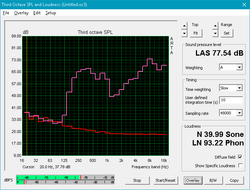
The speakers are excellent. Maximum volume is not terribly loud (capping out at 77.5 dB), but sound quality remains solid. Bass is a bit lacking but is still present, giving some much-needed body to the overall sound. Mids are mellow and highs remain crisp and clear at any volume level. When the music is turned all the way up, there is no distortion. The chassis does vibrate, but this does not produce any rattling or other unwanted sounds. Overall, the speakers are well suited to media consumption and create full, well-balanced sound.
Lenovo Yoga 720-15IKB-80X7 audio analysis
(±) | speaker loudness is average but good (77.5 dB)
Bass 100 - 315 Hz
(±) | reduced bass - on average 12.3% lower than median
(-) | bass is not linear (16.1% delta to prev. frequency)
Mids 400 - 2000 Hz
(±) | reduced mids - on average 5.8% lower than median
(±) | linearity of mids is average (11.1% delta to prev. frequency)
Highs 2 - 16 kHz
(±) | higher highs - on average 5.7% higher than median
(±) | linearity of highs is average (9.2% delta to prev. frequency)
Overall 100 - 16.000 Hz
(±) | linearity of overall sound is average (20.1% difference to median)
Compared to same class
» 55% of all tested devices in this class were better, 7% similar, 38% worse
» The best had a delta of 5%, average was 20%, worst was 53%
Compared to all devices tested
» 50% of all tested devices were better, 9% similar, 42% worse
» The best had a delta of 3%, average was 20%, worst was 65%
HP Spectre x360 15-bl002xx audio analysis
(±) | speaker loudness is average but good (72.9 dB)
Bass 100 - 315 Hz
(±) | reduced bass - on average 14.8% lower than median
(±) | linearity of bass is average (14% delta to prev. frequency)
Mids 400 - 2000 Hz
(+) | balanced mids - only 4.4% away from median
(±) | linearity of mids is average (10.1% delta to prev. frequency)
Highs 2 - 16 kHz
(+) | balanced highs - only 1.2% away from median
(+) | highs are linear (4.9% delta to prev. frequency)
Overall 100 - 16.000 Hz
(±) | linearity of overall sound is average (17% difference to median)
Compared to same class
» 40% of all tested devices in this class were better, 12% similar, 48% worse
» The best had a delta of 3%, average was 18%, worst was 41%
Compared to all devices tested
» 29% of all tested devices were better, 8% similar, 64% worse
» The best had a delta of 3%, average was 20%, worst was 65%
Frequency Comparison (Checkbox selectable!)
Graph 1: Pink Noise 100% Vol.; Graph 2: Audio off
The 135 Watt power adapter included with the Yoga 720 is more than adequate. The system pulls about 10 Watts at idle, which is more than lower-powered convertibles but less than other multimedia or gaming notebooks. Under load, the power efficient components only draw about 67 Watts from the wall. This is about 20-25% less than the HP Pavilion 15t and Samsung Odyssey, both of which have similar internal components. The Dell XPS 15 draws significantly more power under load, but this may be due to the higher resolution 4K panel. The Yoga 720 peaks at 117 Watts, which is about 85% of the rated 135 Watts that the power supply can provide. There is ample headroom for the device.
| Lenovo Yoga 720-15IKB-80X7 i7-7700HQ, GeForce GTX 1050 Mobile, Samsung PM961 MZVLW256HEHP, IPS, 1920x1080, 15.60 | Dell XPS 13 9365-4537 2-in-1 i5-7Y54, HD Graphics 615, Toshiba NVMe THNSN5256GPUK, IPS, 3200x1800, 13.30 | Dell XPS 15 9560 (i7-7700HQ, UHD) i7-7700HQ, GeForce GTX 1050 Mobile, Lite-On CX2-8B512-Q11, IGZO IPS, 3840x2160, 15.60 | HP Pavilion 15t-bc200 X7P44AV i7-7700HQ, GeForce GTX 1050 Mobile, Intel SSD 600p SSDPEKKW256G7, , 3840x2160, 15.60 | Samsung Odyssey NP800G5M-X01US i7-7700HQ, GeForce GTX 1050 Mobile, Samsung PM961 NVMe MZVLW128HEGR, IPS, 1920x1080, 15.60 | Lenovo Legion Y520-15IKBN-80WK001KUS i7-7700HQ, GeForce GTX 1050 Ti Mobile, Samsung PM961 MZVLW256HEHP, IPS, 1920x1080, 15.60 | HP Spectre x360 15-bl002xx i7-7500U, GeForce 940MX, Toshiba XG4 NVMe (THNSN5512GPUK), IPS, 3840x2160, 15.60 | |
|---|---|---|---|---|---|---|---|
| Power Consumption | 24% | -38% | -30% | 1% | -1% | 9% | |
| Idle Minimum * | 8.3 | 8.2 1% | 11.9 -43% | 11.4 -37% | 6.7 19% | 8.5 -2% | 8.14 2% |
| Idle Average * | 10.2 | 10.8 -6% | 17.1 -68% | 14.3 -40% | 8.9 13% | 9.1 11% | 10.91 -7% |
| Idle Maximum * | 10.4 | 12.7 -22% | 17.3 -66% | 14.3 -38% | 10.8 -4% | 9.7 7% | 12.26 -18% |
| Load Average * | 67.5 | 22.6 67% | 94.7 -40% | 82.7 -23% | 81.8 -21% | 79.9 -18% | 45.67 32% |
| Witcher 3 ultra * | 96.5 | 104.8 -9% | 92.2 4% | 97.7 -1% | |||
| Load Maximum * | 117.2 | 24.6 79% | 122 -4% | 131.1 -12% | 122.7 -5% | 121.5 -4% | 74.94 36% |
* ... smaller is better
The 72 Wh should get most users through a full work day. While the notebook's battery only lasts about an hour and a half under load, our WiFi test pegs runtimes at just over 8 hours. Idle times are excellent, hitting almost 18 hours. The Yoga 720 clearly outpaces other multimedia and entry-level gaming notebooks, which offer only about half as much time in real-world use. Thanks to the efficient hardware and software optimizations like Optimus, the Yoga 720 has excellent battery runtimes.
Battery Runtime
| Idle (without WLAN, min brightness) | 17h 46min | |
| WiFi Websurfing | 8h 04min | |
| Load (maximum brightness) | 1h 36min |
| Lenovo Yoga 720-15IKB-80X7 i7-7700HQ, GeForce GTX 1050 Mobile, 72 Wh | Dell XPS 13 9365-4537 2-in-1 i5-7Y54, HD Graphics 615, 46 Wh | Dell XPS 15 9560 (i7-7700HQ, UHD) i7-7700HQ, GeForce GTX 1050 Mobile, 97 Wh | HP Pavilion 15t-bc200 X7P44AV i7-7700HQ, GeForce GTX 1050 Mobile, 63.3 Wh | Samsung Odyssey NP800G5M-X01US i7-7700HQ, GeForce GTX 1050 Mobile, 43 Wh | Lenovo Legion Y520-15IKBN-80WK001KUS i7-7700HQ, GeForce GTX 1050 Ti Mobile, 45 Wh | HP Spectre x360 15-bl002xx i7-7500U, GeForce 940MX, 79.2 Wh | |
|---|---|---|---|---|---|---|---|
| Battery Runtime | -15% | -8% | -33% | -37% | -51% | 15% | |
| Reader / Idle | 1066 | 831 -22% | 552 -48% | 612 -43% | 509 -52% | 866 -19% | |
| WiFi v1.3 | 484 | 410 -15% | 434 -10% | 270 -44% | 263 -46% | 240 -50% | 535 11% |
| Load | 96 | 103 7% | 88 -8% | 76 -21% | 46 -52% | 148 54% |
Pros
+ solid, well-built chassis
+ great keyboard
+ uniform colors
+ great maintenance/upgrade options
+ pressure-sensitive pen support wth Windows Ink
+ exceptional GPU performance
+ pleasing speakers
Cons
- middling port selection
- screen not suitable for outdoor use
- CPU throttles under load
- heavy and big to use as a tablet
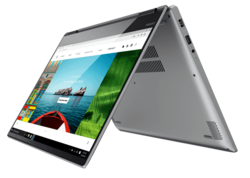
The Lenovo Yoga 15 can be aptly described as a "jack of all trades, master of none." It straddles several different notebook categories and does well in each, but overall makes some compromises to accommodate such a broad range of scenarios. It's a convertible with gaming chops, a multimedia notebook with a 2-in-1 design, and a portable, well-built entry-level gaming notebook. With so many different potential use cases, it's hard to find one thing the Yoga 720 does exceptionally well.
The chassis is exquisitely built and looks subdued and elegant. The keyboard is great for casual users and typists alike. The screen has an even color profile that greatly improves with calibrations. The inclusion of a quad-core CPU and dedicated GPU are welcome additions over the low-powered components typically found in 2-in-1s.
But the port selection is lacking. The keyboard doesn't do anything to stand out. The screen is highly reflective, which is problematic in the wrong lighting. And the CPU is heavily throttled to maintain reasonable temperatures.
Overall, the Lenovo Yoga 720 is a decent "do everything" notebook. It is a very capable and versatile device, bridging the gap between convertible, multimedia, and low-tier gaming devices. While there are notebooks that outshine the Yoga 720 in each of these respective categories, this is a good option for someone in search of an "all-rounder" that packs several different styles of notebook in one package.
Lenovo Yoga 720-15IKB-80X7 - 2017-06-16 06/16/2017 v6(old)
Sam Medley
Convertible - Weighted Average
Pricecompare

I've been a computer geek my entire life. After graduating college with a degree in Mathematics, I worked in finance and banking a few years before taking a job as a database administrator. I started working with Notebookcheck in October of 2016 and have enjoyed writing news and reviews. I've also written for other outlets including UltrabookReview and GeeksWorldWide, focusing on consumer guidance and video gaming. My areas of interest include the business side of technology, retro gaming, Linux, and innovative gadgets. When I'm not writing on electronics or tinkering with a device, I'm either outside with my family, enjoying a decade-old video game, or playing drums or piano.
Sam Medley, 2017-06-20 (Update: 2019-04- 5)
Source: https://www.notebookcheck.net/Lenovo-Yoga-720-15IKB-7700HQ-FHD-GTX-1050-Laptop-Review.227572.0.html
0 Response to "How to Make Blue Stacks Run 60 Fps"
Post a Comment